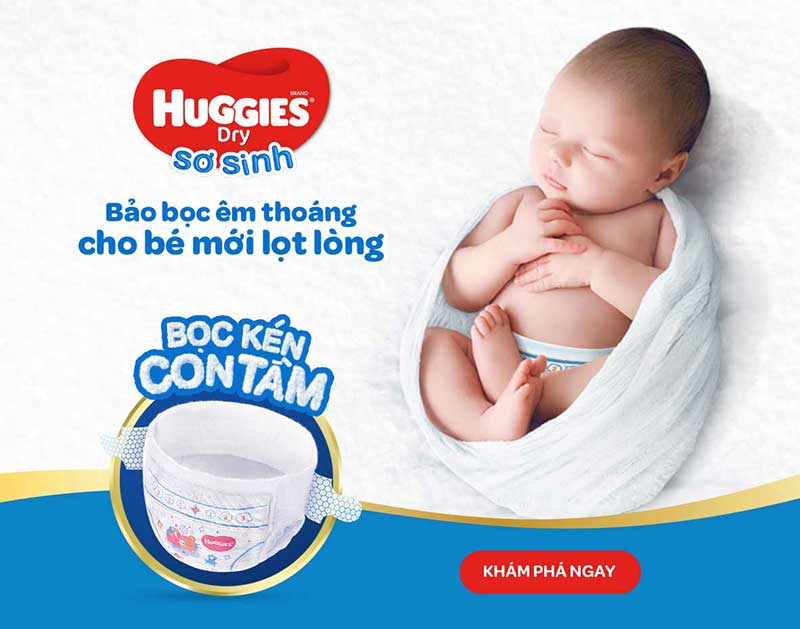You as a parent sometimes don’t realise how important it is to learn about your baby’s poop. The colours and textures as well as the frequency can tell you a great deal about your baby's health. It’s important to learn what could be considered normal and when a red flag needs to be raised.
Huggies Newborn diapers feature a wider waistband pocket to absorb runny bowel movements and that’s one problem we’ve solved for you. Wearing the right size of diaper is equally important to keep your baby from experiencing unnecessary leaks and unpleasant blowouts.
Dissecting the contents
- Meconium is your baby’s very first poop.
- Babies that are breastfed will excrete poop that looks seedy and mustard-like.
- Bottle-fed babies’ poop has a more toothpaste like consistency.
- Any variation of colours yellow, green, or brown is totally normal.
- Consistency of the stool is the most important thing.
- The poop is usually soft and squishy.
- Constipation may occur if baby’s food intakes fluctuate.
- If poop is thin, watery or streaked with mucus and the frequency is higher, she may have diarrhea.
- Any sign of dehydration like dry lips, sunken eyes or sunken fontanels (the soft spot on your baby’s head), it’s best to call your doctor.
- Your baby’s first poop will look like a sticky, greenish-black tar. This is, a mixture of amniotic fluid, bile, and secretions from the intestinal glands. Expect this to pass in the first 24 hours and then the motions improve a few days later.
- If your baby’s poop colour is red/black it is an indication of gastrointestinal bleeding and if it is white, it could represent liver disease and/or nutrient malabsorption.
- A breastfeeding baby may have only one bowel movement a week or one bowel movement with each feeding, both are normal. On the other hand, bottle-fed babies tend to average between one and four a day.
- Any discomfort shown by your baby when she poops something that is thicker than toothpaste or that looks like logs or marbles, then it’s a sign of constipation.
- If constipation persists, some doctors recommend inserting a rectal thermometer for a minute to stimulate the bowel to get moving. A suppository can be prescribed by your pediatrician to move things along.
- Causes of diarrhea could include the consumption of antibiotics, too much fruit juice, milk allergies (not common) or gastroenteritis which is a viral infection that results in vomiting and diarrhea.
- Keep your baby well hydrated with breast milk, formula or pediatric electrolyte solutions.
The switch to solids
- Expect a change in your baby’s poop schedule once she begins to eat solid food which is normally between 4-6 months. The frequency will be lesser, and the stools will become thicker in consistency.
- If your baby’s first food is usually rice cereal fortified with iron, there’s a strong chance of constipation. Switch over to iron-fortified oatmeal or mix in some pureed prunes to ease out the constipated feeling.
- Sometimes your baby’s stools can turn out to be technicolored. Yes, it’s a possibility and don’t be afraid when you see it. It could just mean his/her meals included a variety of vegetables and fruits and it’s usually evident in his/her poop.
- Another thing to not fret over is when you notice certain foods that pass through undigested – like corn. Since babies don’t always chew their food well, their systems tend to process food quickly through the digestive tract.
- Once your baby’s a year old, the wider range of solid foods tend to change the style of the poop too. The smell, colour and texture varies through the day depending on the food your child has eaten. Soon enough, it’ll get more brown and thicker and resemble more like grown-up poop.
Note: Your baby may not poop as often but that shouldn’t stop you from changing the diapers after meals and before naptime or bedtime.
Bathroom or battlefield?
- The need to seek privacy and a fresh diaper are the first signs that your kid is ready to be potty-trained. So, invest in a portable potty.
- Mastering the control over pee comes easily to your child than control over poop.
- Look out for bowel movement cues like grunting or becoming red-faced.
- Many toddlers experience pain as his/her tend to withhold poop due to fear of control.
- Pooping invariably becomes an emotional battlefield for children, rather than just another bodily function.
- Add fiber to your child’s diet.
- Get his/her to sit on the pot every day at the same time. he/she will eventually know what should happen next easing out the experience.









